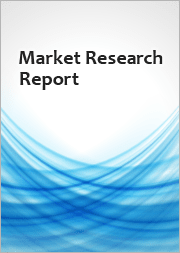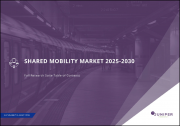
|
시장보고서
상품코드
1763045
세계의 공유 모빌리티 시장 예측 및 전망(2025년)Global Shared Mobility Predictions and Outlook, 2025 |
||||||
오토바이 공유 및 수요형 교통(DRT) 부문이 혁신적인 성장을 추진
세계 많은 도시들이 자동차에 대한 의존으로부터 보다 환경 친화적이며, 공유 및 전동화된 교통 솔루션으로의 전환을 향해, 협조적인 대처를 추진하고 있습니다. 규제는 전기차, 마이크로모빌리티(자전거, 스쿠터 등), 대중교통, 쉐어드모빌리티 서비스 등 보다 친환경 교통수단으로의 이행을 가속시키는 것을 목적으로 하고 있습니다.
최근에는 엄격한 상황이 계속되고 있지만, 2025년의 공유 모빌리티의 전망은 여전히 밝습니다. 지역 간의 협력이 새로운 성장 기회를 약속함에 따라 시장은 진화하고 있습니다.
이 조사의 일환으로 Frost & Sullivan은 주목할만한 규제와 의무, 자금 조달 및 투자 활동, 2025년 업계를 견인하는 중요한 동향을 조사했습니다.
또한 유럽, 북미, 중국, 인도, 호주 및 뉴질랜드, 한국, 라틴아메리카, 중동 등 지역별로 다양한 비즈니스 모델의 성장 기회를 확인하고 있습니다.
목차
분석 하이라이트
- 분석 하이라이트(2024년)
- 공유 모빌리티 시장(2025년) : 예측 vs. 실적
- GMV 예측, 부문별
- GMV 예측, 지역별
- GMV 시장 점유율, 지역별
- 플릿 시장 점유율 내역, 지역별
- 주요 예측(2025년)
성장환경
- 세분화과 정의
- 조사 범위, 부문별
- 주목해야 할 규제와 의무 : 스냅샷
- 자금조달 하이라이트(2024년)
전략적 과제
- 전략적 과제
- 세계의 공유 모빌리티 업계에 대한 전략적 과제 톱 3의 영향
- Growth Pipeline Engine(TM)을 가속하는 성장 기회
세계경제 전망(2025년)
- 경제 하이라이트(2024년)
- 경제 트랜스포메이션(2025년)
- 세계 GDP 성장률의 스냅샷
- 비전 시나리오(2025년)
- 비전 시나리오(2025년) : 세계 성장 예상
- 세계의 리스크와 리스크 경감 전략(2025년)
- 성장 기회, 지역별(2025년)
주요 동향 예측(2025년)
- 공유 모빌리티 : 주요 시장 동향
- 라이드 헤일링·오토바이 쉐어링에 있어서의 전동화의 우위성
- 세계 배포 : 미개척 시장의 확대를 추진
- 틈새 시장에 초점 : 특정 요구에 대응
- 공유 모빌리티에 의한 지방의 모빌리티 향상
- 포커스 전환 : 멀티 모달 허브
- 대중교통기관의 상호운용성
- 로보택시 : 성장 또는 쇠퇴
공유 모빌리티의 지역 분석
- 지역 분석 : 북미 - 2024년·2025년
- 지역 분석 : 유럽 - 2024년·2025년
- 지역 분석 : 중국 - 2024년·2025년
- 지역 분석 : 인도 - 2024년·2025년
- 지역 분석 : 호주 및 뉴질랜드 - 2024년·2025년
- 지역 분석 : 한국 - 2024년·2025년
- 지역 분석 : 라틴아메리카 - 2024년·2025년
- 지역 분석 : 중동 - 2024년·2025년
공유 모빌리티의 업계 분석
- 기존의 카셰어링 : 스냅샷
- 기존의 카셰어링 : 주목 기업
- P2P 카셰어링 : 스냅샷
- P2P 카셰어링 : 주목 기업
- 오토바이 공유 : 스냅샷
- 오토바이 공유 : 주목 기업
- 라이드 헤일링 : 스냅샷
- 라이드 헤일링 : 주목 기업
- 수요형 교통(DRT) : 스냅샷
- 디맨드형 교통(DRT) : 주목 기업
- MaaS : 스냅샷
- MaaS : 주목 기업
- 로보택시 : 스냅샷
- 로보택시 : 주목 기업
성장 기회
- 성장 기회 1 : 지속 가능한 모빌리티를 촉진하는 규제
- 성장 기회 2 : 파트너십과 신기술
- 성장 기회 3 : 자율 기술의 능력
요약
- 결론과 전망
- 업계 전문가의 시점
부록 및 다음 단계
- 성장 기회의 장점과 영향
- 다음 단계
- 자료 목록
- 면책사항
Bikesharing and Demand-responsive Transit Segments Driving Transformative Growth
Globally, many cities are making concerted efforts to shift away from car dependency toward greener, shared, and electrified transport solutions. As the willingness of people to use shared mobility apps increases, governments and cities are enacting policies to reduce carbon emissions, decrease congestion, and promote sustainable transport options. These regulations aim to accelerate the shift toward greener modes of transportation, including electric vehicles, micromobility (e.g., bikes and scooters), public transit, and shared mobility services. Beyond regulations and targets for decarbonization and electrification, cities are also focused on promoting the transition toward sustainable transportation modes.
While recent years have been challenging, the outlook for shared mobility in 2025 remains optimistic. The market is evolving as operators refine their models, technology plays a bigger role, and regional shifts promise new growth opportunities. The total revenue opportunity from shared mobility is projected to surpass $900 billion in 2025.
As part of this research, Frost & Sullivan examines notable regulations and mandates, funding and investment activity, and the critical trends that will drive the industry in 2025. The research includes a deep dive into 7 mobility segments: Traditional carsharing, peer-to-peer carsharing, bikesharing, ridehailing, demand-responsive transit, MaaS, and robotaxis.
The analysis also identifies growth opportunities across various business models by region, including Europe, North America, China, India, Australia and New Zealand, South Korea, Latin America, and the Middle East.
Table of Contents
Analysis Highlights
- Analysis Highlights, 2024
- 2025 Shared Mobility Market: Forecast vs Actual
- GMV Forecast by Segment
- GMV Forecast by Region
- GMV Market Share Split by Region
- Fleet Market Share Split by Region
- Top Predictions for 2025
Growth Environment
- Segmentation and Definitions
- Research Scope by Segment
- Notable Regulations and Mandates: A Snapshot
- Funding Highlights of 2024
Strategic Imperatives
- The Strategic Imperative
- The Impact of the Top 3 Strategic Imperatives on the Global Shared Mobility Industry
- Growth Opportunities Fuel the Growth Pipeline Engine
2025 Global Economic Outlook
- 2024 Economic Highlights
- Economic Transformations for 2025
- Global GDP Growth Snapshot
- 2025 Visioning Scenarios
- 2025 Visioning Scenarios: Global Growth Expectations
- 2025 Global Risks and Risk Mitigation Strategies
- 2025 Growth Opportunities by Region
Predictions of Top Trends, 2025
- Shared Mobility: Key Market Trends
- Electrification's Dominance in Ridehailing and Bikesharing
- Global Expansion: Driving Expansion in Underserved Markets
- Niche Focus: Tailored to Specific Needs
- Shared Mobility to Augment Mobility in Rural Areas
- Shifting Focus: Multimodal Hubs
- Interoperability of Public Transportation
- Robotaxis: Boom or Burn
Shared Mobility Regional Analysis
- Regional Analysis, North America: 2024 and 2025
- Regional Analysis, Europe: 2024 and 2025
- Regional Analysis, China: 2024 and 2025
- Regional Analysis, India: 2024 and 2025
- Regional Analysis, ANZ: 2024 and 2025
- Regional Analysis, South Korea: 2024 and 2025
- Regional Analysis, LATAM: 2024 and 2025
- Regional Analysis, Middle East: 2024 and 2025
Shared Mobility Industry Analysis
- Traditional Carsharing: Snapshot
- Traditional Carsharing: Companies to Watch
- P2P Carsharing: A Snapshot
- P2P Carsharing: Companies to Watch
- Bikesharing: A Snapshot
- Bikesharing: Companies to Watch
- Ridehailing: A Snapshot
- Ridehailing: Companies to Watch
- Demand Responsive Transit: Snapshot
- Demand Responsive Transit: Companies to Watch
- Mobility-as-a-Service: A Snapshot
- Mobility as a Service: Companies to Watch
- Robotaxis: A Snapshot
- Robotaxis: Companies to Watch
Growth Opportunity Universe
- Growth Opportunity 1: Regulations Promoting Sustainable Mobility
- Growth Opportunity 2: Partnerships and New Technologies
- Growth Opportunity 3: Autonomous Technological Capabilities
Key Conclusions
- Conclusions and Future Outlook
- Perspectives from Industry Experts
Appendix & Next Steps
- Benefits and Impacts of Growth Opportunities
- Next Steps
- List of Exhibits
- Legal Disclaimer



















